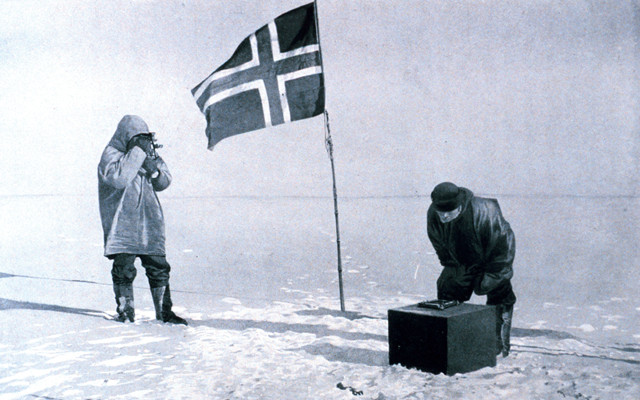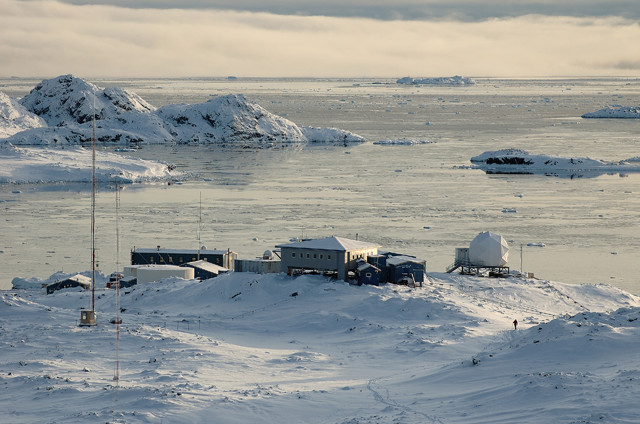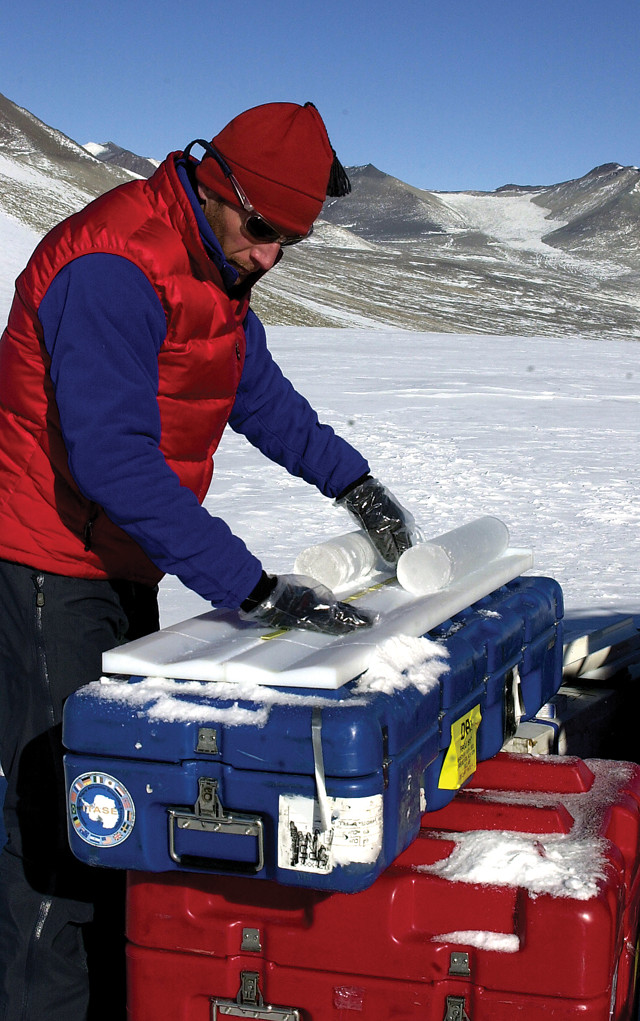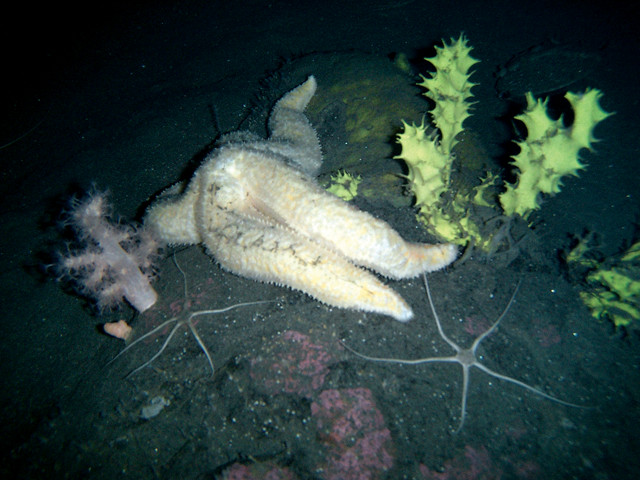
by Zahra Hirji Tuesday, September 1, 2015

In 1911, Roald Amundsen was the first person to mark the South Pole. Credit: Steve nicklas/noS, nGS (noAA).
Science trumps all in Antarctica. For the past 50 years, Antarctica has remained a military-free, globally shared continent, dedicated to peace and scientific advancement, thanks to the Antarctica Treaty.
Signed 50 years ago this month by 12 countries, the treaty was instituted in 1962 and applies to all areas south of 60 degrees south latitude. Today, 44 nations, comprising two-thirds of the world’s population, have signed the treaty. The icy continent, home to fascinating animals and plants, remained undisturbed by humans until the 18th century. In 1772, Captain James Cook, a British naval officer, was exploring the Antarctic Circle on orders of King Charles III in search of the mythical “Terra Australis.” He saw icebergs that hinted that the frozen southern continent did exist, but he did not get a glimpse of the actual mainland. Antarctica was officially discovered in January 1820: Czar Alexander I sent Russian naval officer Captain Fabien Gottleib von Bellingshausen to find Terra Australis before the other European nations. But Russia’s initial vigor to explore Antarctica dissipated abruptly and unexpectedly after Bellingshausen’s discovery — and his findings were not published until more than 10 years after his return to Russia.
British Captain Edward Bransfield and American seal hunter Nathaniel Palmer also made claims to discovering Antarctica, but they were days to weeks behind Bellingshausen. But unlike Russia, the United Kingdom and the United States had no intention of abandoning Antarctica. After 1820, the floodgates opened to further discoveries of specific islands, seas and coastline features by European and American explorers — a combination of tough military men and audacious sealers and whalers in search of resources, adventure and national pride.

There are more than 60 research stations in Antarctica, including Palmer Station, the smallest of the three u.S. Antarctic Program research stations. The population at the station ranges from 10 to 46 people. Credit: Glenn Grant, National Science Foundation.
In 1840, the world caught the first glimmer of Antarctica’s scientific appeal. Sir James Clark Ross, a British naval officer, and his crew discovered an active volcano that he named Erebus (after his ship) on Ross Island, one of the largest islands surrounding Antarctica, and identified 145 new species of fish. By the 20th century, explorers and scientists marched deeper into the white continent. One of the most famous expeditions was led by Roald Amundsen, a Norwegian explorer, and his five-man team in December 1911: They were the first to reach the South Pole, planting a Norwegian flag and beating out rival British explorer, Robert F. Scott. In January 1912, Scott and his team arrived at the South Pole only to discover they had been beaten to the landmark: Amundsen’s flag welcomed them to the bottom of the planet. To make a disappointing journey even worse, all team members perished on the return home.
By the 1950s, Antarctica started to become crowded and various nations began staking out territories. Tensions grew as Argentina, Chile and the United Kingdom made claims to overlapping territories. Still, despite ongoing political turmoil, including the Cold War, scientific collaboration was also gaining momentum. In an effort to “allow scientists from around the world to take part in a series of coordinated observations of various geophysical phenomena,” the International Council of Scientific Unions named July 1957 to December 1958 the International Geophysical Year. That program resulted in international scientific cooperation and globalfocused studies, such as researching Earth’s system of mid-ocean ridges and the discovery of the Van Allen radiation belt — rings of charged particles trapped by Earth’s magnetic field hundreds to thousands of kilometers above Earth’s surface.
The International Geophysical Year also paved the way for the Antarctic Treaty. In 1958, 12 nations — Argentina, Australia, Belgium, Chile, France, Japan, New Zealand, Norway, South Africa, the Soviet Union, the United Kingdom and the United States — joined forces to build a network of more than 60 research stations spread across the Antarctic continent and sub-Antarctic islands designed to collect and monitor atmospheric, oceanic, space and terrestrial conditions on a regular basis. The next year, on Dec. 1, 1959, the same 12 nations came together in Washington, D.C., to draft and sign the Antarctic Treaty.
The treaty established Antarctica as an open scientific laboratory and encouraged international collaboration in pursuit of scientific discovery “and the progress of all mankind.” Military testing and occupation were prohibited.
Since the treaty was enacted in 1962, thousands of astrophysicists, biologists, geologists and many other scientists have flocked to the southern continent, braving the cold, harsh environment each year.
For scientists, Antarctica is a paradise, representing an isolated, relatively undisturbed environment to study. Paleontologists drool over the beautifully preserved and intact fossils, and planetary scientists revel in the abundance of meteorites that are preserved and visible on the ice.

Karl Kreutz from the university of maine measures each section of an ice core as it comes out of the drill on the Clarke Glacier in the mcmurdo Dry Valleys, Antarctica. Researchers use such ice cores to examine past climate change. Credit: emily Stone, national Science foundation.
Antarctica’s scientific potential is not limited to providing a glimpse into Earth’s past. Its icy, isolated environment has led to the development of unusual ecosystems, with many marine and terrestrial species unique to Antarctica. And Antarctica is home to multiple volcanoes, coal deposits and glaciers, not to mention the world’s largest ice sheet and subglacial lake.
As times have changed, so have the threats against Antarctica’s preservation and scientific integrity. Antarctica may have survived the Cold War, but it is not in the clear yet. As the environmental implications of fishing and mining began to emerge in the late 20th century, the pristine nature of Antarctica was once again put into question. The ninth article of the original treaty calls for continual interaction and discussion among its signatories to address upcoming and changing concerns.
Between the 1970s and 1990s, the signatories emplaced a series of four conventions and protocols to further protect Antarctica. In 1972, they ratified the Convention on the Conservation of Antarctic Seals; the signatories followed that up in 1980 with the Convention on the Conservation of Antarctic Marine Living Resources.

Diplasterias burcei, a starfish species, is common near Antarctica. This photo was taken beneath five meters of sea ice in mcmurdo Sound. Credit: Henry Kaiser, National Science Foundation.
In 1988, protection of Antarctica’s environment was expanded to include nonliving things with the Convention on the Regulation of Antarctic Mineral Resource Activities. The convention was designed to regulate exploration and exploitation of Antarctic minerals in case such an industry surfaced.
It took the signatories six years to settle on the measures for the mineral convention, and even then all the parties were not satisfied. Additional measures were taken in 1991: Mining (except for scientific research) was banned altogether with the Protocol on Environmental Protection to the Antarctic Treaty. Providing broader protection of the Antarctic environment than previous conventions, the protocol called for an environmental assessment of any future human activities in Antarctica — including those of a scientific nature.
Today there is a new emerging concern: tourism. “Strengthening environmental regulation is especially important as tourism to Antarctica increases,” U.S. Secretary of State Hillary Clinton told the 32nd Antarctic Treaty conference in Baltimore, Md., last April. The conference attendees agreed to be watchful and mindful of their respective tourismrelated impacts on Antarctica, but no regulations or amendments specific to tourism were proposed. Between 2008 and 2009, approximately 27,000 tourists made their way to Antarctica — a number only expected to increase in the future.
© 2008-2021. All rights reserved. Any copying, redistribution or retransmission of any of the contents of this service without the expressed written permission of the American Geosciences Institute is expressly prohibited. Click here for all copyright requests.